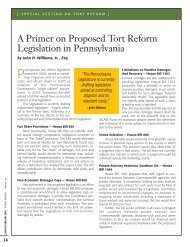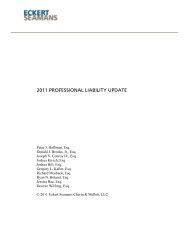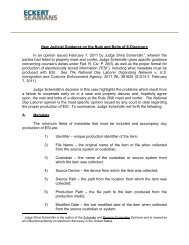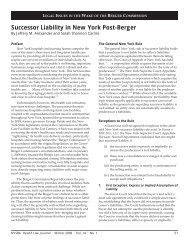(c)Limitations of Corporate NegligenceUntil relatively recently, neither the Supreme Court of Pennsylvania nor the StateSuperior Court had addressed the issue of whether the doctrine of corporate liability should beextended to physicians’ practices or professional corporations. Then, in Sutherland v.Monongahela Valley Hospital, 856 A.2d 55 (Pa. Super. Ct. 2004), in a very brief section of itsopinion, the Superior Court “declined” Defendant-physician’s “invitation to extend thenegligence principles contemplated by Thompson” to the physician’s practice. While thisopinion held only that the court would not extend the negligence principles of Thompson “to thecase sub judice,” the reasoning of the court appears to apply more generally. The court reasoned:Id. (citations omitted).We note that the policy considerations underlying the PennsylvaniaSupreme Court’s creation of the theory of corporate liability forhospitals are not present in the situation of a physician’s office. InThompson, the Supreme Court recognized that “the corporatehospital of today has assumed the role of a comprehensive healthcenter with responsibility for arranging and coordinating the totalhealth care of its patients.” The same cannot be said for aphysician’s practice group.However, in Zambino v. Hospital of the University of Pennsylvania, No. 06-3561, 2006U.S. Dist. LEXIS 69119 (E.D. Pa. September 25, 2006), the United States District Court for theEastern District of Pennsylvania denied Defendants’ motion to dismiss Plaintiff’s corporatenegligence claim against Defendant hospital trustees, health system and practice group. Thecourt noted that although the Pennsylvania Supreme Court has not addressed the extension ofcorporate liability to medical providers other than hospitals, other courts (such as thePennsylvania Superior Court in Shannon v. McNulty, infra) have extended this doctrine to otherentities in limited circumstances “such as when the patient is constrained in his or her choice ofmedical care options by the entity sued, and the entity controls the patient’s total health care.”The court held that Plaintiffs were entitled to develop a factual record to support the applicationof this theory to Defendants, and that they may be able to show that Defendants were hospitalentities against whom they could maintain a corporate negligence claim.In Hyrcza v. West Penn Allegheny Health System, Inc., 978 A.2d 961 (Pa. Super. Ct.2009), reargument denied, 2009 Pa. Super. LEXIS 4448 (Pa. Super. Sept. 11, 2009), the SuperiorCourt confronted numerous objections raised by Defendant-appellants, a physician and aprofessional corporation, after a trial on claims sounding in medical malpractice and corporatenegligence resulted in the entry of a multi-million dollar judgment against them. One of thearguments the Superior Court confronted on appeal, was whether the jury should have beencharged on the issue of corporate negligence, with respect to the appellant professionalcorporation. The appellant corporation argued that professional corporations are not liable undera theory of corporate negligence. The Superior Court acknowledged its prior decision inSutherland v. Monongahela Valley Hospital, 856 A.2d 55 (Pa. Super. Ct. 2004), in which it haddeclined to extend the doctrine of corporate negligence to physicians’ offices. Ultimately,however, the Hyrcza Court concluded that the appellant corporation was more in the nature of a72
hospital or HMO, as to whom corporate negligence claims have been found viable. Citing toboth Thompson v. Nason Hospital, 591 A.2d 703 (Pa. 1991) and Shannon v. McNulty, 718 A.2d828 (Pa. Super. Ct. 1998), the Hyrcza court concluded that the trial court did not err in chargingthe jury on corporate negligence.By way of additional background, the professional corporation at issue held an agreementwith the rehabilitation unit of a hospital, “to provide medical care for patients admitted to itsRehabilitation Unit.” Hyrcza, 978 A.2d at 966 (quoting the Trial Court Opinion). Theprofessional corporation was responsible for the decision to assign the Defendant-appellantphysician to Decedent’s care, following Decedent’s successful hip surgery. Plaintiff theorizedthat Defendant physician erred in prescribing and continuing decedent “on two medications,which, in combination, are known to cause stomach bleeding, without taking appropriateprecautions or monitoring her.” Id. at 967 (quoting the Trial Court Opinion). Apparently,Decedent had showed signs of gastrointestinal bleeding on July 4, 2001, two days prior to thetime that the Defendant-appellant physician left the professional corporation’s care. On July 8,2001, the decedent had to be transferred to the intensive care unit for shortness of breath; shedied two days after that, “from massive gastrointestinal bleeding.” Id. at 967 (quoting the TrialCourt Opinion). Notably, after the appellant physician left the professional corporation’semploy, the professional corporation did not assign another physician to Decedent’s care. Id.The Superior Court wrestled with whether Defendant-appellant corporation was moreakin to a Hospital or HMO on the one hand, or a physician’s office on the other, the latter ofwhich no liability attaches to under a corporate negligence theory. The trial court found that:[Defendant-appellant] arranged and coordinated the total healthcare for its patients in the Rehabilitation Unit. [The appellantcorporation]was responsible for all of the medical care of patientsin the Rehab Unit. There was testimony from physicians affiliatedwith [the appellant-corporation] that the corporation had all theduties of a hospital under [Thompson] except the duty to usereasonable care in the maintenance of safe and adequate facilitiesand equipment . . . .. . .After [the appellant-physician] left, [the appellant-corporation] didnot assign another physician to attend to Decedent. It did notarrange for another physician to check on her after July 5 th ,literally leaving her in the Rehabilitation Unit bleeding to death.Id. at 983. The Superior Court concluded that the appellant corporation was “responsible for thecoordination and management of all patients in the rehabilitation unit at [the hospital], which itindependently operated,” and that it “failed to deliver the comprehensive care it wascontractually obligated to provide the Decedent.” Id., at 984. The Superior Court thus agreedwith the trial court’s decision to charge the jury regarding corporate negligence.73
- Page 3 and 4:
EMTALA CASES ......................
- Page 5:
Filing an Affidavit of Non-Involvem
- Page 8 and 9:
II.PROFESSIONAL LIABILITY - AN OVER
- Page 10 and 11:
The Superior Court reversed the tri
- Page 12 and 13:
to a third party pursuant to the st
- Page 14 and 15:
After approximately five months, De
- Page 16 and 17:
learned the day after the surgery t
- Page 18 and 19:
conduct to the delay in colon cance
- Page 20 and 21:
court admitted the expert’s testi
- Page 22 and 23:
(b)(c)other reasonable causes, incl
- Page 24 and 25:
corroborated his testimony. The cou
- Page 26 and 27:
husband’s estate. Plaintiff alleg
- Page 28 and 29: Other notable federal cases arising
- Page 30 and 31: The Superior Court found that in re
- Page 32 and 33: § 1303.512(b). The court, however,
- Page 34 and 35: In Neidig v. United States, No. 07-
- Page 36 and 37: Additionally, the Supreme Court not
- Page 38 and 39: were not indicated for her conditio
- Page 40 and 41: surgeon is the same as it would be
- Page 42 and 43: It should be noted that the Superio
- Page 44 and 45: Finally, the court held that the tr
- Page 46 and 47: The Supreme Court of Pennsylvania r
- Page 48 and 49: nurses deviating from applicable st
- Page 50 and 51: certainty, the court reviews expert
- Page 52 and 53: Under Pennsylvania law, the Court n
- Page 54 and 55: testimony, Defendant presented his
- Page 56 and 57: Following Cooper v. Roberts, 286 A.
- Page 58 and 59: Plaintiff developed chronic diarrhe
- Page 60 and 61: where payment is made by Medicaid w
- Page 62 and 63: accomplished. In Valles v. Albert E
- Page 64 and 65: In 1980, the Pennsylvania Superior
- Page 66 and 67: Plaintiff had a routine monitoring
- Page 68 and 69: Plaintiff’s Contract ClaimsThe Co
- Page 70 and 71: is a failure to report changes in a
- Page 72 and 73: unit to assure post-surgical patien
- Page 74 and 75: sliced his wrist and arm with a raz
- Page 76 and 77: licensed professionals for whom the
- Page 80 and 81: Even more recently, our Superior Co
- Page 82 and 83: (a)HMO IssuesIn McClellan v. Health
- Page 84 and 85: affidavit submitted by Defendants o
- Page 86 and 87: treatments while at VA’s faciliti
- Page 88 and 89: [s]ubstantively, we believe that a
- Page 90 and 91: The party claiming the benefit of t
- Page 92 and 93: deprive (him) of civil rights guara
- Page 94 and 95: found that the District Court was w
- Page 96 and 97: With respect to fraudulent concealm
- Page 98 and 99: would be applied in situations wher
- Page 100 and 101: they had not raised them in the cou
- Page 102 and 103: (a)Informed ConsentUnder MCARE, a p
- Page 104 and 105: civil enforcement provisions and ma
- Page 106 and 107: MCARE also changes the manner in wh
- Page 108 and 109: whose death, in 2005, was allegedly
- Page 110 and 111: vicariously liable if the plaintiff
- Page 112 and 113: health center or its equivalent or
- Page 114 and 115: In Pennsylvania Medical Society, th
- Page 116 and 117: to any professional who is alleged
- Page 118 and 119: Since the 2005 amendments, there ha
- Page 120 and 121: ule, but who intentionally ignores
- Page 122 and 123: the original Complaint was delivere
- Page 124 and 125: foreclose all challenges against th
- Page 126 and 127: number of boxes), which was support
- Page 128 and 129:
questions of professional judgment
- Page 130 and 131:
deviated from any professional stan
- Page 132 and 133:
The Third Circuit affirmed the Dist
- Page 134 and 135:
claims and cross-claims remain agai
- Page 136 and 137:
By an Amendatory Order dated March
- Page 138 and 139:
The court acknowledged that there i
- Page 140 and 141:
apply and that the trial court misa
- Page 142 and 143:
Barbados had enough litigation-spec
- Page 144 and 145:
E. Preemption of Vaccine Design Def
- Page 146 and 147:
2. Pa. R. Civ. Pro. 1036.1 - Reinst
- Page 148 and 149:
Barrick, at *34-35.Furthermore, the
- Page 150 and 151:
(b) the utility of the defendant’
- Page 152 and 153:
2006). In this case, Plaintiffs bro
- Page 154 and 155:
B. Elements of a Cause of Action fo
- Page 156 and 157:
decision in Muhammad precluded Mr.
- Page 158 and 159:
considered speculative “only if t
- Page 160 and 161:
underlying cause of action involved
- Page 162 and 163:
In Capital Care Corp., the Superior
- Page 164 and 165:
The court found, however, to state
- Page 166 and 167:
of reasonable diligence. The standa
- Page 168 and 169:
not be set aside. On July 7, 2005,
- Page 170 and 171:
complete bar to recovery. Since a l
- Page 172 and 173:
On appeal, Plaintiffs claimed that
- Page 174 and 175:
In Liggon-Redding, 659 F.3d at 265,
- Page 176 and 177:
elieved of those minimum standards
- Page 178 and 179:
elevant to the proceedings, the com
- Page 180 and 181:
establish professional misconduct b
- Page 182 and 183:
Upholding the Superior Court’s Or
- Page 184 and 185:
Id.Rejecting revocation and suspens
- Page 186 and 187:
order as a sanction under Rule 4019
- Page 188:
{1009912]182









